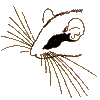

Dormouse Talk Instructions and Archives
How to Subscribe
Compliled and Edited by Werner
Haberl
Number of recipients: > 125
Please share your thoughts and answers with the rest of the group!
Replies to the following messages should be sent as CC-Mail to dormouse@glirarium.org
Dear Dormousers,
First, a big "Thank You" to all of you who have visited and supported the Dormouse Hollow.We are going into our 2nd calendar year.
2000 proved that the newsletter and the website are likely to become even more widely used fora. The issues included a variety of discussions and contributions by our rapidly growing number of subscribers and members, a group that is constituted of (ca. 130!) 'dormouse people' ranging from amateur naturalists to students, academics and 'dormouse popes', not to mention the professional wildlife photographers, rehabbers and other interested participients. I thank you all for keeping the 'thing' going and for your obvious mental support reflected in your numerous letters. I would also like to thank all those who have sent me their publications (books and reprints of research papers) and photographs. Please keep on announcing your new publications. I am thankful for receiving reprints and copies to add to the Dormouse Bibliography.
I hope that those of you who are taking an active interest have been satisfied with Dormouse Talk and that many of the 'accidental' surfers have found useful bits of information. I would appreciate any comments or ideas for the future.
However, I would like to remind you that English is the official language for this newsletter. Please excuse the 2 messages in German and Italian in this issue of DT.
Enjoy this first issue of DT 2001 and please contribute by sharing your ideas with the rest of the group. We have a growing number of highly interested non-scientists as recipients and they are all eager to read what is going on in our brains. Science is not for scientists only and we should appreciate that.
Let's make this year a productive and enjoyable one, putting together DT Volume 2.
Yours shrewly,
Werner
Editor of Shrew Talk and Dormouse Talk
Dear Rainer,
Something a little similar I observed in Muscardinus, but in very small extent. I caught 9 individuals (among more than 2000), which had a rims of white hairs around eyes. They looked like wearing eye-glasses. In 5 cases I can affirm, that this was not innate features, because normal animals were marked with rings and recaptured later with changes in coloration. In some cases small white spots appeared in fur of marked dormice. It seems that these changes are related with the age of dormice.
Best wishes,
Rimvydas
Dr. Rimvydas Juškaitis
Institute of Ecology, Akademijos 2, LT-2600 Vilnius, Lithuania
The next 6th European Workshop will be held in Italy in September 2001. Because I think that many dormousers are interested in other tree rodents too, I ask you if you could send this message in the next Dormouse Talk and put a link in The Dormouse Hollow web-site.
For the occasion we prepared a web site where you could find more information on the programme and the place of the next workshop, and where you could filling a preliminary registration form.
www.agraria.unito.it/dip/divapr/wr
Please foreward this message to any other person or Institution you think would be interested in the Workshop.
All the best,
Sandro Bertolino
DIVAPRA Entomology & Zoology
Via L. da Vinci 44
10095 Grugliasco (TO), Italy
Dear Collegues,
I wish all of you a happy and successful new year first of all.
May I ask for your help in my research. I am looking for publications in the topic of morphology and statistical analysis of morphological features of (small) mammal species. I need them for an article and a diploma work on the differentiation of dormouse populations based on statistical analysis of morphological features. I would be very grateful if you could send me a copy of your articles connected to this topic. I am also interested in any suggestion where else can I find such publications (names, institutes, web-sites, addresses etc.).
Thank you very much in advance for your kind cooperation.
Yours sincerely:
Botond Bakó
Department of Zoology and Ecology
Szent István University,
Páter K. u. 1.
Gödöllő-2103, Hungary
Caro Maurizio,
Scusami se non mi sono fatta sentire dopo il nostro incontro ma ho avuto miliardi di cose da fare. Ho buttato gi- qualcosa per l'introduzione al libretto ma vorrei parlarne con te. Oggi ti ho cercato alle 17:00 in istituto ma te ne eri gi- andato. Non ti avevo chiamato prima in quanto non ero passata di l- appositamente. Ti mando per punti quello che forse dovrebbe rappresentare l'introduzione. Butta gi- qualunque idea tu abbia, saranno ben accette.
Vediamoci al pi- presto magari prima della fine di questa settimana. Telefonami se non riesco a rintracciarti io prima !
un abbraccio Daria
Sehr geehrter Herr Haberl,
Ich bin 25 jähriger Medizinstudent an der Uni Innsbruck. Vergangenen Sommer fand meine Freundin in Oberösterreich einen ~5 Tage alten Siebenschläfer. Nach erfolgreicher Aufzucht (mit Hilfe von Hr. Dr. Ulrich von der innsbrucker Zoologie) bis zur 7. Woche ist ihr der kleine Kletterer ausgebüchst. Jetzt ist sie bestrebt einen Siebenschläfer oder Haselmaus als Haustier zu halten, da sie von ihrem Ex-Siebenschläfer so begeistert ist. Die gesetzl.Bestimmungen kenne ich wohl, versuchen aber dennoch einen Siebenschläfer für meine Freundin zu finden. Vielleicht haben Sie eine Idee, wie man einen "notdürfigen" Siebenschläfer bekommt,
Ich bedanke mich für Ihre Zeit,
Simon Gmeiner
Dr. Glatz-Str.22
6020 Innsbruck
Austria
This section has not been included in the archive version.
Number of Visitors (Date: 5 September 2000): >1380 Number of recipients: >120
Dormouse Talk Instructions: ... how to join, post & leave
Dr. Werner Haberl
Editor of DORMOUSE TALK & SHREW TALK
Chair, Insectivore Specialist Group
Species Survival Commission
IUCN - The World Conservation Union
Hamburgerstr. 11, A-1050 Vienna, Austria
Email: dormouse@glirarium.org
The Dormouse Hollow: www.glirarium.org/dormouse
The Shrew Shrine: members.vienna.at/shrew
IUCN / ITSES: members.vienna.at/shrew/itses.html
Back to Dormouse Talk Archives / Index